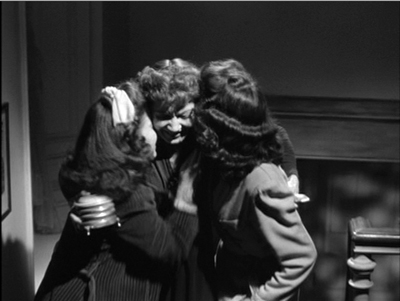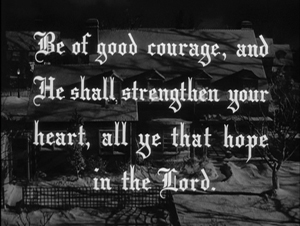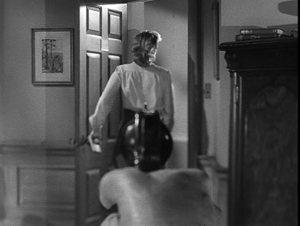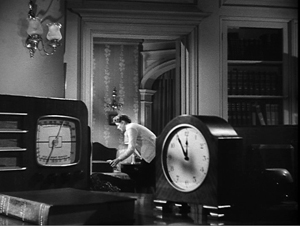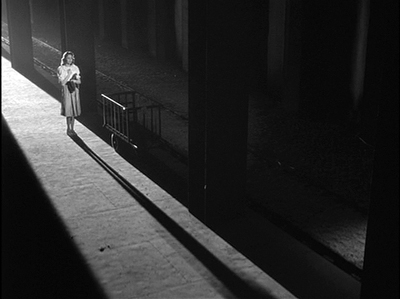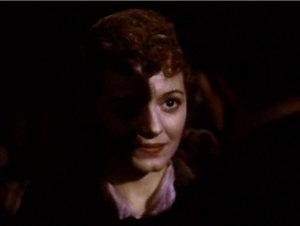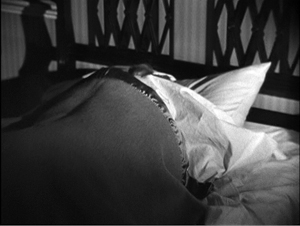A dose of DOS: Trade secrets from Selznick
Monday | December 17, 2012 open printable version
open printable version
David O. Selznick dictating a memo in 1941. Secretaries are Virginia Olds (back to camera) and Frances Inglis.
DB here:
Tucked neatly within over 4500 archive boxes in Austin, Texas, are tens of thousands of items of information about how the Hollywood studio system worked. The trick is to find the ones you’re looking for…and the ones you didn’t know you should be looking for.
Those archive boxes are housed at the Harry Ransom Research Center at the University of Texas. This magnificent research library holds cultural records of inestimable value, from Whitman and Poe manuscripts to the papers of David Foster Wallace. Among the Center’s impressive film collections, the jewel in the crown is the David O. Selznick papers—a vast trove of material related to the career of the man who produced, some would say over-produced, Gone with the Wind, Rebecca, Spellbound, Duel in the Sun, and other classics of the Hollywood system.
Selznick has been studied from many angles, partly because his collection provides exceptionally full accounts of his activities. He kept, it seems, nearly everything, most famously memoranda. While chainsmoking cigarettes, swallowing amphetamines, writing amateur poetry, and revising scripts and visiting sets and critiquing rehearsals and watching rushes and retaking scenes and checking on rivals’ films, Selznick found time to dictate a blizzard of memos.
From his youth he loved to write memos–“I could sell an idea much better in written form than I could verbally”–and he became adept at dictating them. The results were precise, punchy, and often eloquent. Usually signed DOS (the O being a middle initial he bestowed upon himself), these communiqués could be lapidary (a one-liner asking if the cast is protected from sunburn) or epic. After getting Selznick’s dense, eight-page telegram explaining why Since You Went Away’s nearly three hours could not be reduced, a colleague replied: IF I WERE YOU I WOULD MAKE NO FURTHER CUTS IN SYWA. YOU MIGHT TAKE ABOUT TEN MINUTES OUT OF YOUR TELEGRAM.
In his later years Selznick contemplated publishing a collection called Memo Strikes Back. After he died in 1965, his son encouraged film historian Rudy Behlmer to make a compilation. The result, Memo from David O. Selznick (1972), is a superb collage portrait of the man’s personality and creative years. In the 1980s, the Ransom Center acquired the papers that Behlmer worked through, along with physical artifacts, including costumes from GWTW.
Me-mos, they were called by many, since they seemed to reflect the compulsive micromanaging of their creator. Directors and staff smarted under Selznick’s insistence that he control every creative decision. But for those of us coming afterward, Selznick’s criticisms, complaints, demands, reminiscences, agonies of frustration, and I-told-you-sos help us grasp the concrete problems of filmmaking.
Last week I went to Austin hoping to get some information about how Hollywood creators of the 1940s regarded the task of storytelling. DOS delivered as he did on the screen: splashily.
Paper traces
William Cameron Menzies production sketch for Gone with the Wind.
Most commentary on movies stops with the films as we find them. Critics who concentrate on producing interpretations are particularly inclined to play down primary-document research. “We already know,” a famous English critic once told me, “all we need to know.”
In my youth I mostly agreed. Criticism starts with watching and listening closely to what’s happening on the screen. But it doesn’t have to end there. That’s because doing systematic research into film depends on asking questions. And if we’re going beyond a single movie and asking questions about craft, norms, preferred practices, and regulative principles shaping a filmic tradition–in short, questions of film poetics–evidence from practitioners can help a lot.
Hollywood, for instance, has produced a rich array of published materials–interviews, trade coverage, promotion, technical papers–that offer evidence of what filmmakers thought they were doing. You have to read them with a jaundiced eye and be alert for rhetoric, but there’s still a lot to be found in Hollywood’s public presentation of its doings. There’s an even richer lode of unpublished script drafts, production memos, correspondence, transcripts of meetings, court cases, and the like. Mountains of such material remain locked up in studio files. This is what makes the paper collections at major universities, at the Margaret Herrick Library of the Academy, at the Museum of Modern Art, and at other institutions precious to those of us studying film history.
Collections like these are grist for the perpetual flow of celebrity biographies and accounts of Hollywood as a business. What, though, can they tell us about the history of film form and style?
Like some published material, these items can suggest how aware filmmakers were of their creative choices. When I was teaching, and the class focused on details of framing or cutting, some students were skeptical. “This is reading too much in,” they’d say. “The director couldn’t have intended that!” And it’s true that sometimes things we think were carefully planned came about through accident or sudden inspiration. Still, in other cases a document shows that filmmakers were consciously aiming at fine-grained effects.
Moreover, archive documents can indicate the array of creative options available—the extent to which one artistic choice is preferred over alternatives that wouldn’t work as well. If filmmaking is problem-solving, we learn about the costs and benefits of competing solutions. We gain a better sense of what can and can’t be done within a tradition when we glimpse filmmakers struggling to decide between expressive possibilities.
Yet another benefit of paging through archival documents is the recognition that we can’t neatly separate filmmaking as business from filmaking as an art. We commonly imagine a studio producer ordering a director to take the cheapest option, to trim costs in every way. Surely this happened a lot. Surprisingly often, though, the suits did and still do invest a lot in artistic effects, even innovative ones. When writing our book The Classical Hollywood Cinema: Film Style and Mode of Production to 1960, we were struck by the power of the idea of the “quality film,” that mixture of novelty, showmanship, and high production values that justifies time and resources. A flamboyant crane shot, a complicated lighting scheme, a gorgeous musical score, flashy special effects—in the Hollywood tradition and others, these are appeals worth paying for, even if not every viewer appreciates them.
Perhaps above all, studying records can call our attention to aspects of the film that your initial impression didn’t pick out. A critic can’t notice everything. Examining collections such as Selznick’s, or those housed in our Wisconsin Center for Film and Theater Research, have taught me that what appears effortless or perfunctory on the screen can be the product of intense thought, protracted debate, and hours of hard work. Once you re-tune your attention, even minor moments can be worth thinking about, if only because the filmmakers labored patiently over them.
Getting what you pay for
Since You Went Away (1944).
Selnick was a fussbudget on a scale that makes Schulz’s Lucy look laid-back. He sought control over every aspect of the film, from purchase of material through production, post-production, publicity, and distribution. Gone with the Wind’s volcanic success seemed to confirm the wisdom of his endless tracking of every detail. Because that tracking is made explicit, not to say vehement, in his memos and other correspondence, we get glimpses of Hollywood’s artistic strategies large and small.
Start small. In The Classical Hollywood Cinema: Film Style and Mode of Production, I wrote about the “rule of three”–the guideline that presses filmmakers to state important story information three times, preferably with variations (serious/ funny/ pathetic). I gleaned that precept from reading published work, and I could check it by studying the films. Still, further evidence is always welcome, so it’s nice to see a transcript of a story conference during the prolonged rewriting of Portrait of Jennie (1949). The hero, the painter Eben Adams, comes to a coastal town in search of his dream-girl, and DOS suggests:
In every scene he is to ask: “Do you remember a girl named Jennie Appleton?” Use rule of three–two [townfolk] do not remember her–the third one does. . . “Remember her well. . . pretty young thing with dark hair.”
More recently, I’ve been wondering whether studio screenwriters of the 1930s and 1940s were consciously adhering to something like today’s notion of a three-act structure. I’ve found scattered evidence from memos elsewhere that refer to a movie’s “first act” or “last act,” but nothing that indicates a commitment to an overarching three-part layout.
I haven’t found clear-cut evidence in DOS’s papers either, but in another story conference on Jennie, Broadway showman Jed Harris is reported as saying: “The second act–he must get the picture back because that’s all he’ll ever have of her.” In the finished film, Eben doesn’t search for the portrait, but Harris’s remark indicates that he had some sort of multiple-act structure in the back of his mind. He adds later: “The picture at this point is about 1/3 gone, and from here you have the machinery of trying to stop what is impossible to stop.” Far from definitive evidence, but teasing.
Now consider a medium-size example. Kristin and I have argued that many Hollywood films have a symmetrical opening-and-closing structure, often presented as an epilogue that mirrors the beginning. More recently I suggested that this bookend structure often displays an advance/ retreat pattern. At the start, the camera may move into a space or a character may come toward us; at the end, the camera may retreat and/or the characters may turn away or walk into the distance. On Since You Went Away (1944), Selznick sweated over ways to frame this panorama of the American home front. Early on he decided to start his film with an exterior view of the Hilton family home. This image dissolves to a closer view showing a star in the window, which indicates that a member of the family is in the armed forces.
Eventually Selznick decided to end the film by pulling back from a miniature of the house, with a single camera movement replacing the two unmoving shots that started things off. Anne is joyfully embracing her two daughters; they’re inserted as a matte into the upstairs window.
Selznick considered redoing the opening as a slow camera movement in to the window, but only if the miniature was good enough. Perhaps it wasn’t. And at one point he wanted the final shot to start with the star in the window, at least for purposes of the preview screening, “to parallel that at the beginning of the picture.” Again, that wasn’t accomplished, but his playing with possibilities reflects his tradition’s commitment to symmetrical openings and closings.
It would have been far cheaper simply to have ended the film on the three-shot of the women, shown at the top of this section. But Selznick wanted “a nice rounded feeling” in his epilogue, and he was prepared to pay for it. True, he was exceptionally finicky, but going to a lot of trouble and expense to get this formal rhyme was not unusual in studio practice. The hardheaded film business is willing to invest in vivid, emotionally gripping artistry identified with quality moviemaking.
Stylistic trends
Portrait of Jennie (1949).
In broad terms, it’s fair to say that American studio films of the 1940s display a more self-conscious use of long takes, sustained camera movements, and deep-focus cinematography than we find in other eras. (Actually, it’s a trend we find throughout the world at the time, for reasons that aren’t well understood.) But these new techniques didn’t replace traditional analytical editing. They worked within it. Continuity cutting, established in America in the late 1910s, remained the dominant stylistic framework for filmmakers.
Citizen Kane‘s fixed single-shot scenes in depth were very unusual in cinema of the period. More commonly, deep-focus shots, like moving-camera shots, served as establishing framings or otherwise became part of conventionally edited sequences. This middling or compromise style can be found in dozens of films of the forties, and Selznick seems to have more or less consciously gone along with it.
He worried about what he called “cuttiness,” the tendency to break every scene into brief single shots of the players. Often, he suggested, a well-handled two-shot would work better. He told his editor on Since You Went Away to avoid “the conventional treatment of close-ups and reactions.”
It most definitely is not necessary always to treat every one of our scenes with dead center close-ups, and direct cuts or over-the-shoulder angles, when an intimate scene is played between two people.
He goes on to tell a second-unit director that a scene of a couple in a car could be played in one or two setups, perhaps in a single shot “if we could get an interesting composition on the two of them rather than a dead center two-shot on individuals.”
Selznick saw Hitchcock as an editing-biased director and so after signing him to make Rebecca (1940), he warned him and other members of the team to avoid over-cutting. Again, the preference was for a tight two-shot.
The new scene between the girl and Mrs. Danvers on the arrival at Manderley (Script Scenes 130A, 130N and 131) may be very cutty as described in the script, and perhaps ought to be protected in a close two-shot of ‘I’ [the heroine] and Mrs. Danvers, or some other angle that will keep us from playing it in too many short cuts.
In most cases, however, Selznick gave himself an out by treating faster cutting as an alternative. He consistently wanted coverage, as he indicates immediately for the Rebecca scene just mentioned.
However, I suggest we make the short cuts also, as this may be the best way of playing it after all. If we use the camera to move up to Mrs. Danvers for the finish, which is the way I think it should be used, then perhaps the first shot of her should be retaken also.
As the last sentence indicates, Selznick sometimes opts for camera movement to avoid cuttiness. Perhaps the American Hitchcock’s interest in tracking shots that follow characters, particularly glamorous women, through the set stemmed from Selznick’s belief in the power of occasional camera movements. He notes that a tracking shot introducing Alida Valli in The Paradine Case (1948) is too bumpy, asking why the staff couldn’t manage “something as simple as going up to a woman’s face, and then pulling back from it across a set, without the camera shaking in the manner of early silent pictures.”
Yet these longish takes aren’t to be the dominant stylistic approach. Sustained takes often block off choices in post-production. Producers, then and now, want coverage, and you didn’t have to be a micromanager like Selznick to want your directors to give you options for rebuilding scenes in the cutting room. We see this when Selznick objects to John Cromwell’s playing entire scenes in lengthy shots.
This is of course nonsense, since as often as not an incomplete take is better than the identical portion of a complete take. . . . It seems folly to spend hours getting a complete scene instead of just picking up those sections of the beginning or middle or end that have been fluffed.
Some directors resisted by shooting long takes without coverage. Hitchcock did this in one sequence of The Paradine Case and then promoted this “three and a half-minute take” to the Hollywood community, perhaps to make it harder for Selznick to change it. Nonetheless, Selznick cut the scene up. Once freed from Selznick, of course, Hitchcock was able to pursue the long-take option to extremes with Rope (1948) and Under Capricorn (1949).
Despite wanting flexibility in editing, producers can be seduced by the prospect of “pre-cutting” a film–planning the shots so exactly that the film can be “pre-visualized.” The director can thus avoid taking shots that won’t be used. Selznick was proud of William Cameron Menzies’ precise production planning on Gone with the Wind, and this made him believe in the power of the storyboard. When he rewrote a script, which was often, he was inclined to have artists immediately prepare fresh drawings of sets and shots.
Hitchcock had promoted himself as someone who drafted a film on paper so thoroughly that shooting became efficient and predictable. Selznick was therefore startled when Hitchcock proposed a long shooting schedule for Rebecca. “In view of the many speeches he has made to me about how he pre-cuts a script, so as to shoot only necessary angles, it is a mystery to me as to how he could spend even 42 days.”
During shooting, DOS became furious with the pace of production, declaring Hitchcock “the slowest director we have had.” Hitchcock, he believed, was spending more time getting his few angles than directors who shot in normal fashion. Yet Selznick remained susceptible to the dream of pre-cutting. Some years later, he predicted that Since You Went Away wouldn’t take much time in the editing room because the scenes “will be camera-cut to an extra-ordinary degree, and putting it together should take no time at all.” The film’s editing occupied several months.
Selznick, then, was attracted to current trends of longish takes and the fluid camera, but like nearly all his peers he saw these as subordinate to the overarching demands of analytical editing, whether through traditional protection coverage or through “pre-cutting.” Something similar seems to have governed his interest in depth staging and deep-focus cinematography. Peppered throughout the memos I examined are his concern for “foreground pieces,” props that can enliven a shot. A miniature sailing ship in Portrait of Jennie, he suggests, is too big for its placement in the shots as taken. “It would have been a far better foreground piece for another angle.” So it became such a piece, as the still surmounting this section indicates.
Of Since You Went Away DOS notes:
I think that lately we have been overlooking chances for good foreground and background planes in our set-ups. I don’t want to over-do this but of a lot of our shots could be much more interesting in this regard.
In particular he emphasizes the bronzed baby shoes introduced in the film’s opening, as the camera glides through the Hilton family parlor picking up traces of the departed father. A later scene, in which Anne writes a letter to her husband Tim, seemed the ideal chance to re-use that prop. “Photographically, I thought it would be much more interesting with the shadow of the shoes, or using the shoes as foreground pieces.” This composition, if it was shot, didn’t appear in the final film, but it shows once again that filmmakers can be aware of broader trends of their period, and that they’re willing to go to considerable trouble to join them.
A striking example of the insistence on participating in the deep-focus trend appears in the files around Spellbound. After arriving in America, Hitchcock occasionally produced some big-foreground depth images, as below in Shadow of a Doubt (1943), and in Notorious (1946).
Such compositions were rare in most films Hitchcock did under Selznick, but in Spellbound Selznick realized the value of keeping up-to-date. The most famous big foreground in the film (and in all Hitch’s work) is seen at the climax, when Dr. Murchison trains his revolver on Constance as she edges out of his office.
This bizarre shot is somewhat anticipated by a less aggressive setup. Constance hears over the radio that the police have tracked J. B. to Manhattan, and she goes into the next room to pack to follow him. The action is handled in a canonical post-Kane composition.
The production records make me wonder whether this shot (presumably using a larger-than-life clock and radio) was filmed under Hitchcock’s supervision. It may have replaced an even more complex shot that cinematographer George Barnes objected to. (I’m still gathering information on this.) In any event, Selznick realized that a minor transitional scene could be dynamized by a flamboyant, difficult-to-achieve image: a throwaway mark of quality.
Pendulum swings of innovation
Since You Went Away.
I’ll save other things I found for future work. Let me finish by talking about how Selznick’s “directing at a distance” shows a craftsman’s concern for novelty and pictorial storytelling.
Hitchcock famously shot the Old Bailey scenes of The Paradine Case with several cameras in an immense set. Selznick may have okayed this tactic on this occasion because it would speed up Hitchcock’s schedule. (Selznick had hoped it would take only one day; it took three for principal photography and several more for pick-up inserts.) But both before and after Paradine, Selznick was interested in extending multiple-camera shooting beyond its normal uses.
Multiple-camera coverage of ordinary scenes had a heyday in the early years of sound, but afterward it was usually reserved for unrepeatable action (fires, stunts, cars going off cliffs) or very big scenes. Selznick had deployed several cameras, including the lightweight Eyemos, during the dance at the airplane hangar in Since You Went Away. Like Welles, he also considered using the tactic for ordinary dramatic scenes. He writes in 1947:
I have long felt that sooner or later, probably when economic necessity dictates, this method of shooting will come into vogue, with far more time spent on rehearsal, far less time on shooting, enormous savings and better quality. I know that for years I have been discussing with Hitchcock my feeling that we could take a film of a particular type, thoroughly rehearse it, and shoot it in a week–and this is just what Hitch is planning to do on The Rope [sic].
Selznick anticipated the practice of multiple-camera television production. It’s intriguing to think of Hitchcock taking this idea and simply substituting one camera for many, creating another technical stunt that could be publicized.
DOS was sensitive to conventions and often sought to refresh them. For one back-projected scene of Portrait of Jennie, he advises Dieterle “to avoid the awful-looking, head-on, two-shot process setups and angle camera in different ways: perhaps with lower cameras, one shooting across Adams at Spinney and the other shooting across Spinney at Adams.” This echoes his concern for finding unusual angles on the process arrangement in Since You Went Away‘s driving scene. He likewise encouraged unusual staging, recalling
the love scene between Freddie March and Janet Gaynor in A Star Is Born, the one in which he takes her home the first night, after the kitchen scene, where the entire scene is played on Freddie’s back; and the love scene in Nothing Sacred in the crate after Carole Lombard has fished Freddie March out of the river. Both of these treatments enormously enhanced the value of these scenes, which shot conventionally would not have been necessarily so effective.
In the first instance, the conversation is handled by an unusually prolonged over-the-shoulder shot that doesn’t show March replying to Gaynor. In the second, the romantic dialogue is emphasized by the darkness of the crate and our inability to see either actor clearly.
Yet Selznick worried about becoming too “arty” as well. During the filming of Since You Went Away he confessed:
I feel that I am at least partially responsible for our increasing tendency to play scenes on people’s backs. . . . In Jane’s attack upon the colonel after the breakfast scene, we are on neither one principal nor the other, but on the colonel’s back and Jane’s back . . . In the church scene there has been talk of playing it on the three backs, but I have tried in the script to indicate that we should not do this.
Stark lighting is of course common in 1940s cinema generally, but Selznick favored it in the 1930s as well, in the shots above and more famously in Gone with the Wind. By the 1940s, Since You Went Away and Portrait of Jennie include scenes steeped in rich shadow areas, cast shadows, and silhouettes.
But here, as elsewhere, DOS’s urge for innovation was curbed by anxiety about going too far. In a memo to Cromwell on Since You Went Away, he wrote that “all of us (mostly myself) are overdoing the silhouette business. . . . Let’s from now on all use this silhouette effect very sparingly, and only when it’s absolutely indispensable to our mood.”
Perhaps what I’ve called his middle-of-the road approach was less a balance and more of a pendulum swing between extremes. He could sometimes foreswear the grand, almost monumental look of many scenes and demand something quieter. At the end of the day when Anne’s husband has left for war, she looks at his unmade bed.
She leaps up and wriggles into it, covering her face with the blankets, and starts to cry.
Commentators often fasten on the twin-beds convention as an example of the naive timidity of studio-era Hollywood. Yet every convention offers opportunities for expression. When Anne rises, the sight of one rumpled bed and one pristine one brings home the husband’s absence in a simple, powerful image, and her plunging into it directly conveys her longing to be in his arms.
I’m absolutely positive that this gag will not get over unless we see the two beds in the clear, one made up and one not made up, before she hops into the other bed. I think these two beds constitute good storytelling.
When the hard-bitten Ben Hecht saw Since You Went Away, he cabled Selznick: “It made me cry like a fool.”
You can certainly argue that Selznick the fussbudget was his own worst enemy. His micromanagement raised his budgets and drove away his collaborators. As the production values grew more inflated, it was hard to recoup costs, let alone turn big profits. Ten years after Gone with the Wind premiered, Selznick’s fiefdom lay in ruins. He withdrew from production, millions of dollars in debt. He wrote in a confidential 1948 memo:
In the final analysis it is my fault for two reasons: (1) my production methods; (2) my tolerance through the years of the wastefulness. . . . The most successful series of pictures ever made in the history of the business has produced profits which are perhaps not more than twenty per cent of what they should be.
Ideas matter in any domain, even in studying Hollywood. And not just the ideas of critics, historians, and theorists. The practicing artisans of the studio system had rich ideas about preferred ways to build plots, to shoot and cut scenes, to mix sound and add music. These norms were seldom stated outright. Were Selznick less interfering, less prone to hesitate between alternatives, less obsessed with minute details, we would not know as much about the workings of the system he sought to rule. He distilled into typescript and double carbons many notions that ordinarily went unstated. His plump files teem with ideas about how films were made, and how their creator thought they should affect audiences. Thanks to institutions like the Ransom Center, his work is preserved to enlighten us about filmmakers’ secrets, even the secrets they don’t know they know.
I’m very grateful to Emilio Banda and the rest of the staff at the Harry Ransom Center, who helped me during my visit. Thanks also to Steve Wilson, Curator of Film there, for advice. And of course thanks to my family–Diane, Darlene, Kewal, Kamini, Megan, and Sanjeev–who made our trip to Austin so enjoyable.
My quotations come from the memos I examined, as well as from other items in Rudy Behlmer’s Memo from David O. Selznick. I also drew on Ronald Haver’s David O. Selznick’s Hollywood (Knopf, 1980), the initial edition of which is surely the most gorgeous book ever published about the American film industry. Haver’s study is not only spectacularly illustrated but deeply researched, and it, like Behlmer’s, is indispensable for the study of the studio system. The Menzies production sketch is taken from the Haver volume.
No less indispensable is Leonard J. Leff’s Hitchcock & Selznick (Weidenfeld and Nicolson, 1987). After sifting through both the Selznick collection in Austin and the Hitchcock collection at the Academy’s Margaret Herrick Library, Leff produced a detailed account of the two men’s creative work. Hitchcock’s long take in The Paradine Case is promoted in Bart Sheridan, “Three and a Half Minute Take…,” American Cinematographer 27, 9 (September 1948), 304-305, 314.
Paul Ramaeker offers a subtle account of Portrait of Jennie as a “supernatural romantic melodrama” at The Third Meaning.
For more on 1940s stylistic norms, see The Classical Hollywood Cinema, chapter 27, and On the History of Film Style, chapter 6. The first essay in my Poetics of Cinema discusses Hitchcock in relation to trends of the period, concentrating on Rope and long-take options. On Citizen Kane and rationales for deep-focus cinematography, you can go here. I mention a bit about the fashion for the “fluid camera” in 1940s Hollywood in this entry.
William Cameron Menzies served as art director and more for Gone with the Wind, and he and was pressed into service ad hoc for later DOS projects. I think he may have influenced the shadow-drenched style of Since You Went Away and Portrait of Jennie. I wrote about Menzies’ work, and again about deep-space work in 1940s Hollywood, here and here. See also David Cairns’ enlightening essay in The Believer.
Since You Went Away: “I think that Miss Keon had better start preparing a script of retakes and additional scenes. I think we missed a wonderful opportunity in the Christmas scene in not having a shot from the angle of the family, or from the bottom of the stairs, of the Colonel going up the stars with Soda behind him.”














